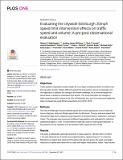Files in this item
Evaluating the citywide Edinburgh 20mph speed limit intervention effects on traffic speed and volume : a pre-post observational evaluation
Item metadata
| dc.contributor.author | Nightingale, Glenna | |
| dc.contributor.author | Williams, Andrew James | |
| dc.contributor.author | Hunter, Ruth | |
| dc.contributor.author | Woodcock, James | |
| dc.contributor.author | Turner, Kieran | |
| dc.contributor.author | Cleland, Claire | |
| dc.contributor.author | Baker, Graham | |
| dc.contributor.author | Kelly, Michael | |
| dc.contributor.author | Cope, Andy | |
| dc.contributor.author | Kee, Frank | |
| dc.contributor.author | Milton, Karen | |
| dc.contributor.author | Foster, Charlie | |
| dc.contributor.author | Jepson, Ruth | |
| dc.contributor.author | Kelly, Paul | |
| dc.date.accessioned | 2022-01-05T11:30:02Z | |
| dc.date.available | 2022-01-05T11:30:02Z | |
| dc.date.issued | 2021-12-31 | |
| dc.identifier | 276988204 | |
| dc.identifier | edd8914f-d61f-4836-85fd-d7854c39f418 | |
| dc.identifier | 85122014817 | |
| dc.identifier | 000773555700031 | |
| dc.identifier.citation | Nightingale , G , Williams , A J , Hunter , R , Woodcock , J , Turner , K , Cleland , C , Baker , G , Kelly , M , Cope , A , Kee , F , Milton , K , Foster , C , Jepson , R & Kelly , P 2021 , ' Evaluating the citywide Edinburgh 20mph speed limit intervention effects on traffic speed and volume : a pre-post observational evaluation ' , PLoS ONE , vol. 16 , no. 12 , e0261383 . https://doi.org/10.1371/journal.pone.0261383 | en |
| dc.identifier.issn | 1932-6203 | |
| dc.identifier.other | ORCID: /0000-0002-2175-8836/work/105957166 | |
| dc.identifier.uri | https://hdl.handle.net/10023/24597 | |
| dc.description | Funding: The ‘Is 20 plenty for health?’ project is funded by a National Institute for Health Research (NIHR) Public Health Research (PHR) grant 15/82/12. | en |
| dc.description.abstract | Objectives: Traffic speed is important to public health as it is a major contributory factor to collision risk and casualty severity. 20mph (32km/h) speed limit interventions are an increasingly common approach to address this transport and health challenge, but a more developed evidence base is needed to understand their effects. This study describes the changes in traffic speed and traffic volume in the City of Edinburgh, pre- and 12 months post-implementation of phased city-wide 20mph speed limits from 2016-2018. Methods: The City of Edinburgh Council collected speed and volume data across one full week (24 hours a day) pre- and post-20mph speed limits for 66 streets. The pre- and post-speed limit intervention data were compared using measures of central tendency, dispersion, and basic t-tests. The changes were assessed at different aggregations and evaluated for statistical significance (alpha = 0.05). A mixed effects model was used to model speed reduction, in the presence of key variables such as baseline traffic speed and time of day. Results: City-wide, a statistically significant reduction in mean speed of 1.34mph (95% CI 0.95 to 1.72) was observed at 12 months post-implementation, representing a 5.7% reduction. Reductions in speed were observed throughout the day and across the week, and larger reductions in speed were observed on roads with higher initial speeds. Mean 7-day volume of traffic was found to be lower by 86 vehicles (95% CI: -112 to 286) representing a reduction of 2.4% across the city of Edinburgh (p=0.39) but with the direction of effect uncertain. Conclusions: The implementation of the city-wide 20mph speed limit intervention was associated with meaningful reductions in traffic speeds but not volume. The reduction observed in road traffic speed may act as a mechanism to lessen the frequency and severity of collisions and casualties, increase road safety, and improve liveability. | |
| dc.format.extent | 14 | |
| dc.format.extent | 812565 | |
| dc.language.iso | eng | |
| dc.relation.ispartof | PLoS ONE | en |
| dc.subject | 20mph speed limits | en |
| dc.subject | Public health | en |
| dc.subject | Transport | en |
| dc.subject | Evaluation | en |
| dc.subject | RA0421 Public health. Hygiene. Preventive Medicine | en |
| dc.subject | 3rd-DAS | en |
| dc.subject | SDG 3 - Good Health and Well-being | en |
| dc.subject.lcc | RA0421 | en |
| dc.title | Evaluating the citywide Edinburgh 20mph speed limit intervention effects on traffic speed and volume : a pre-post observational evaluation | en |
| dc.type | Journal article | en |
| dc.contributor.institution | University of St Andrews. School of Medicine | en |
| dc.contributor.institution | University of St Andrews. Population and Behavioural Science Division | en |
| dc.identifier.doi | 10.1371/journal.pone.0261383 | |
| dc.description.status | Peer reviewed | en |
This item appears in the following Collection(s)
Items in the St Andrews Research Repository are protected by copyright, with all rights reserved, unless otherwise indicated.

